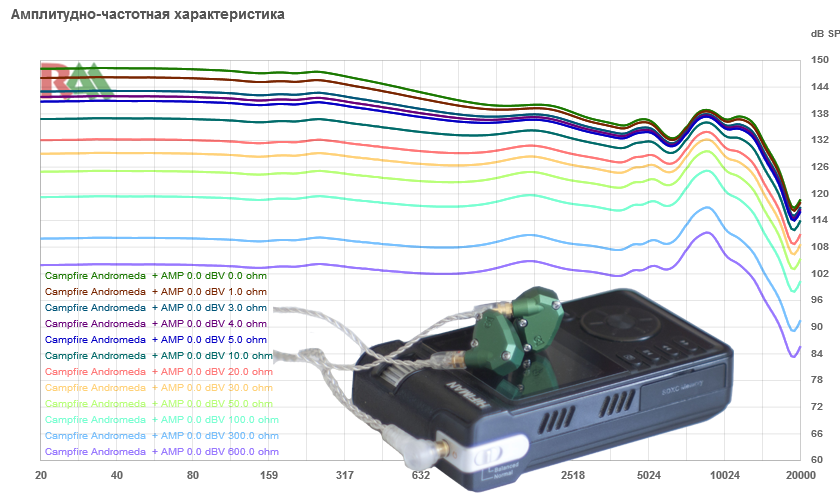
We are launching on the RAA website another service of on-line comparisons of changes in frequency response and sound pressure, depending on the supplied voltage and source impedance.
About the appearance of the service
In the on-line service "
frequency response from the interaction of headphones and amplifier " shows the frequency response relative to 0 dB in the form of the final result is similar to setting the equalizer.
In the
new service, this is displayed through the frequency response to the absolute sound pressure in dB SPL, taking into account the sensitivity of the headphones when giving a signal with known voltage and resistance at the amplifier output.
This construction shows the root cause of changes in the frequency response. Since the service was conceived not only informative, but also useful for practical use, additional parameters were added to it.
Now, in the first article about the new service there will be a more cognitive theoretical part.
Consider everything in order.

The main examples will include
Campfire Andromeda headphones. Such an honor of this model fell behind the impetus for the creation of this on-line service. The fact is that Andromeda has a very low and uneven impedance. This model, no matter how praised it, is very contradictory and capricious. And it is through such a new on-line service that it is easier to show its features.
Such plotting in Reference Audio Analyzer software was laid out at the end of 2010. Charts have been used in a number of articles. We assumed, gradually, to make graphing available in the on-line comparisons service. Model Campfire Andromeda gave us that push.
Because of what and how to change the frequency response of the headphones when connected to an amplifier?
The dependence of the voltage level of the resistance of the headphones and amplifier
The amplifiers have an output impedance.
If it is close to 0 ohm, it is called "zero". A feature of such amplifiers is the constant value of the output voltage, regardless of the nominal value of the connected load. That is, if 0 dBV was set at the output of the amplifier (0 dBV is 1 V
RMS in decibels), then when headphones with 16, 32, 60, 150 and 600 Ohm resistances are connected, 0 dBV will go to the headphones. (1 V
RMS ).

On the output voltage graph, this looks like a straight line. Horizontally on the graph shows the headphone resistance in ohms and dB (ohms), and the vertical voltage in dBV (where 0 dB is the voltage of 1 V
RMS ). Voltage is expressed in decibels (dBV) for further simple calculations with headphone sensitivity.
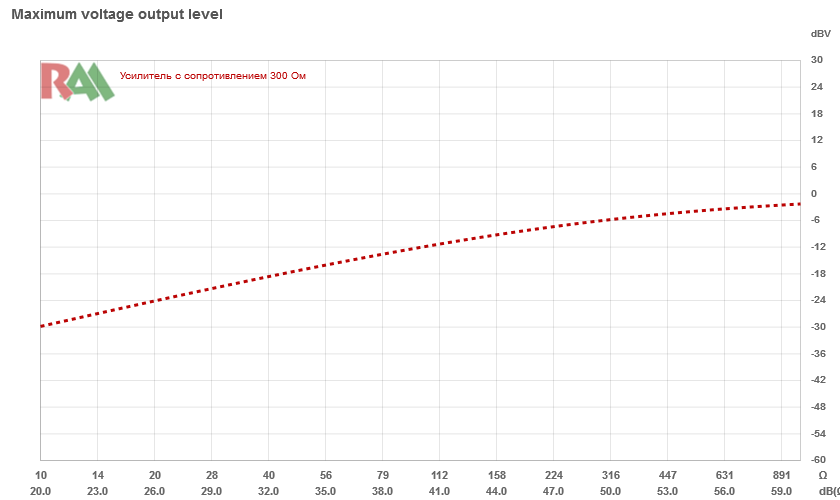
If the amplifier output resistance is not zero, then when connecting the load voltage level will decrease. Moreover, the higher the resistance of the amplifier and / or the lower the resistance of the load (headphones), the stronger the voltage level will decrease. The example shows an amplifier with a resistance of 300 ohms, which, as in the previous example, without a load gives 0 dBV output. The difference in dB for the voltage on the graph shows how much the sound pressure level of the headphones decreases. When connecting the load (in the form of headphones) to 20 Ohms, we see on the graph the value of -24 dBV. This means that when you connect these headphones, the amplifier will be quieter at 24 dB! And it may happen that low-impedance headphones with high sensitivity with such an amplifier can play quieter than high-impedance ones with low sensitivity.
In the on-line comparison service “
power and sensitivity ” you can experiment by setting different values of the “amplifier by parameters”. Examples include:
0 ohm ,
30 ohm and
300 ohm .
In general, the impedance of the amplifier can be considered as an additional series resistance on the wire at the headphones. Those. You can take an amplifier with zero resistance and a thin wire with a resistance of 10 ohms, or you can connect headphones with a thick cable with zero resistance, but to an amplifier with a resistance of 10 ohms and the result will be the same.
Total, if we have the amplifier resistance is not zero, the voltage level (volume) will decrease when headphones are connected. If the headphone resistance is constantly in the entire frequency band, it will simply reduce the signal level, and the frequency response will remain the same. A different situation will be with headphones, in which the resistance is different in the reproduced frequency band.
Separately, you can look at
the calculation formula .
Effect of amplifier and headphone impedance on frequency response
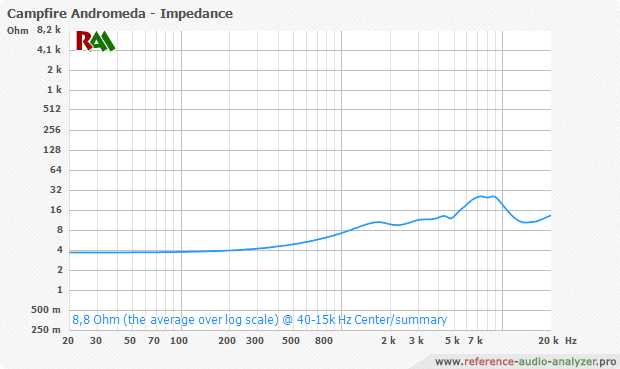
The horizontal resistance graph shows frequencies from 20 to 20,000 Hz, and vertical resistance, the logarithmic scale. The graph for Campfire Andromeda shows that in the low frequency range the resistance is around 4 ohms, and in the high frequency range (7-9 kHz) it reaches 30 ohms.
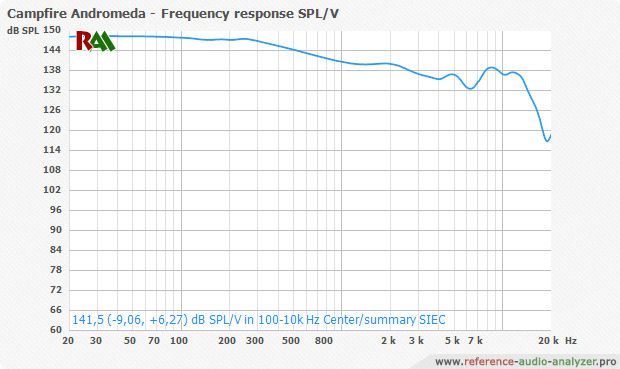
The sensitivity graph shows the frequency response of headphones in the form of absolute sound pressure, which is obtained when playing a sine with an amplifier with zero resistance and voltage level V
RMS .
With such a low resistance, a very high sensitivity is obtained, above 140 dB / V SPL. Accordingly, such headphones are capable of playing very loudly from silent sources.
It is also clear that the low frequencies at Campfire Andromeda are 9 dB louder than the high frequencies and the headphones could be called bass. But not all Campfire Andromeda owners agree that the headphones are really loud and bass (and moreover, we are pleased to mention that the graphics are “lying”, but the sound is completely different - the sensitivity is normal, but there is no bass). And in part they will be right.
Let us turn to a new
on-line service , in which we will be able to follow the change in the frequency response, taking into account the sensitivity.
To build a graph, you need to select a bundle from the headphone model and amplifier. The default settings for the amplifier are 0dBV (1 V
RMS ) and 0 Ω. The schedule is added one bundle at a time. The number of bundles will be limited only by the length of the URL string when forming the POST request.
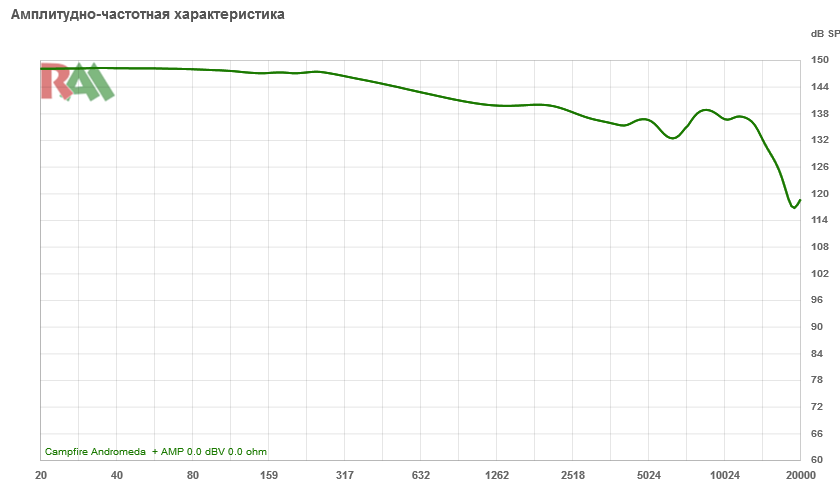
Here, a pair of
Campfire Andromeda headphones
and an amplifier with the specified parameters are selected as 0 dBV output voltage (1 V
RMS ) and 0 Ohm output impedance. Those. This is the original generally accepted sensitivity chart, as in a professional report. So a similar graph will be in a
simple service of on-line comparison of the frequency response in the sensitivity display mode.
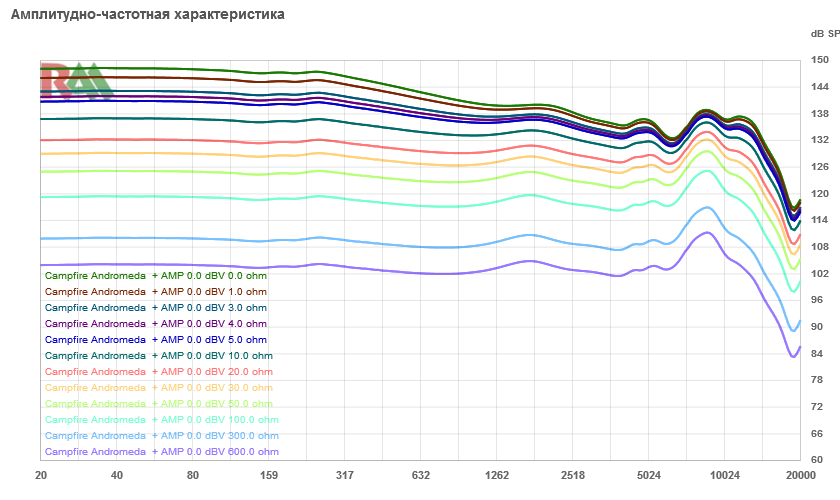
Add more pairs for
Campfire Andromeda with amplifiers, which will differ only in output resistance .
We see that the higher the impedance of the amplifiers, the lower the frequency response curve, the lowest line is obtained with an amplifier with 600 Ohms. At the same time, low frequencies are reduced more noticeably than high frequencies and if with an amplifier with 0 Ohm headphones can be called bass, then with an amplifier with a resistance of 20 Ohms they are already neutral, the level of low frequencies is comparable to the level of high frequencies (without taking into account the peak in 8 kHz) With a further increase in the resistance of the amplifier frequency response does not change much, but sags in level.
Hide most of the graphs , leaving only a couple of frequency response.
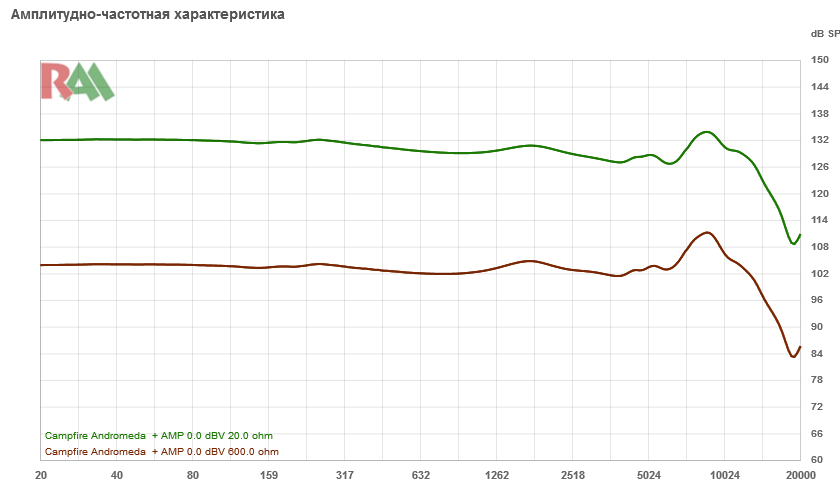
When connecting Campfire Andromeda to amplifiers with resistances of 20 and 600 Ohms, the frequency response will hardly differ, but the volume will differ by 28 dB. In this case, with other headphones with higher resistance, the difference between the amplifiers will be less.
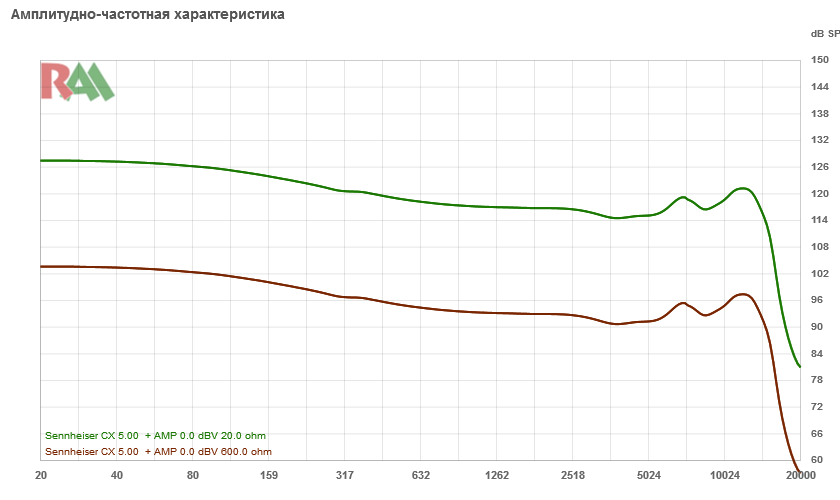
For example, with a
Sennheiser CX 5.00 with a resistance of about 20 ohms under similar conditions, the difference will already be 24 dB.
If we combine Sennheiser CX 5.00 and Campfire Andromeda on one graph, adding amplifiers with zero resistance and not considering the 600 ohm version, we get the following picture:
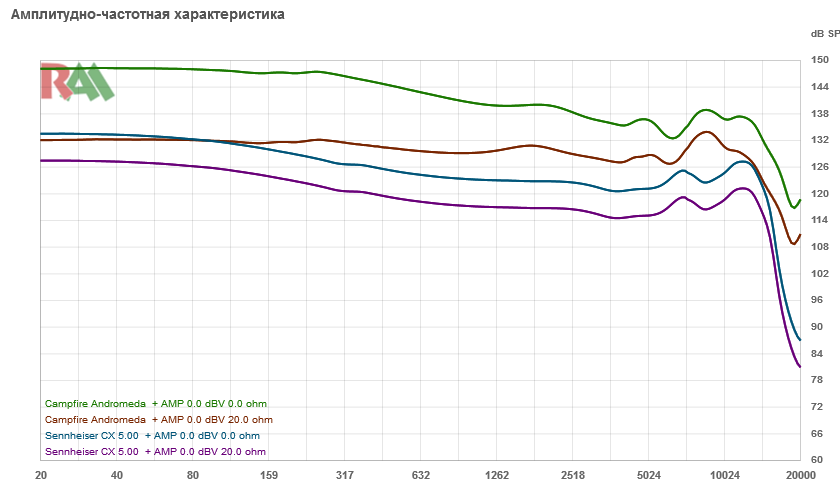
With an amplifier with 0 ohms, the difference in volume between Campfire Andromeda and Sennheiser CX 5.00 will be 17 dB, while when connected to an amplifier with 20 Ohms, from 6 dB in the low frequency range, to 13 dB in the high frequency range.
More contrasting situation with
Sunrise Dragon Ear Tips Earbuds R130 Close (120 ohm headphone impedance)
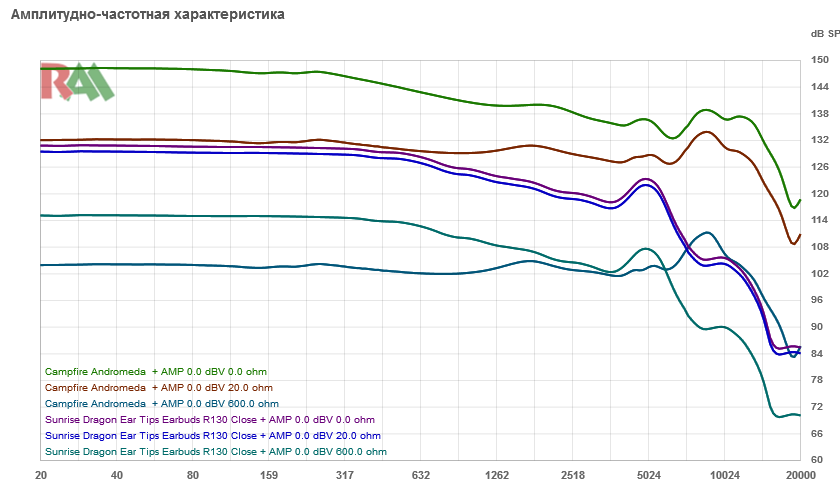
When connected to an amplifier with an impedance of 0 ohms, the difference between Campfire Andromeda and Sunrise Dragon Ear Tips Earbuds R130 Close is 16 dB. When connected to an amplifier with a resistance of 20 ohms, the difference between the headphones is only 3 dB. And when connected to an amplifier of 600 ohms, the low sensitivity and high impedance Sunrise Dragon is 11 dB louder!
Of course, in reality, amplifiers with a resistance of 600 ohms are extremely rare, usually for transformerless tube amplifiers, the resistance varies from 60 to 150 ohms, and 300 ohms can be found in power amplifiers for speakers with an additional headphone jack.
However, if you
sort the sources (amplifiers) according to the output impedance according to the measurement database , the Fly FS504 Cirrus 2 smartphone has a high resistance and it is 130 Ohms.
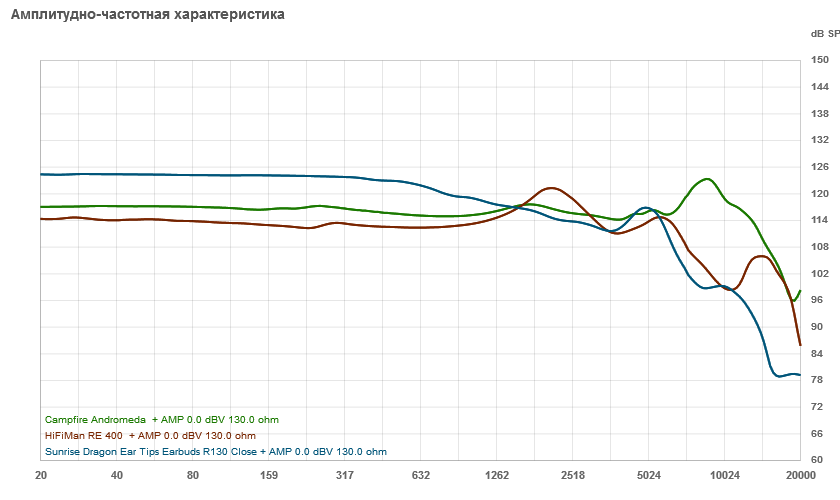
With this Campfire smartphone, Andromeda will be slightly louder than the HiFiMan RE 400 and quieter than the Sunrise Dragon Ear Tips Earbuds R130 Close. And, of course, the owner of a similar phone (albeit more expensive, but with similar output resistance) will argue that Campfire Andromeda’s high sensitivity is a myth in the fevered brain of sales people-marketers and paid authors and bloggers. Since the headphones are "quiet", who does not agree, he saw the headphones only in the picture ...
Campfire Andromeda and HiFiMan HM901 Balanced Card

Take an alternative example, close to reality, and not comedic with the owner of expensive headphones and a smartphone (unfortunately, in life this is not uncommon). For example, with Campfire Andromeda and HiFiMan HM901 high-end player with a balanced card (amplifier). With a balanced card, the player can work both in normal mode and in a more “loud” balanced mode.
In
balanced mode , the amplifier resistance is 11.3 ohms and the maximum voltage without load is 13.46 dBV. In
unbalance mode, 0.3 Ohm and 7.44 dBV, respectively.

Those. In unbalanced mode, the amplifier is quieter by 6 dB - twice. However, due to the higher impedance in the balanced mode for low-impedance headphones, the difference in volume will be less, for 16 ohm it will be 1.5 dB. The graph of voltages clearly shows how the curve for the balanced mode smoothly decreases in the field of low-resistance loads.
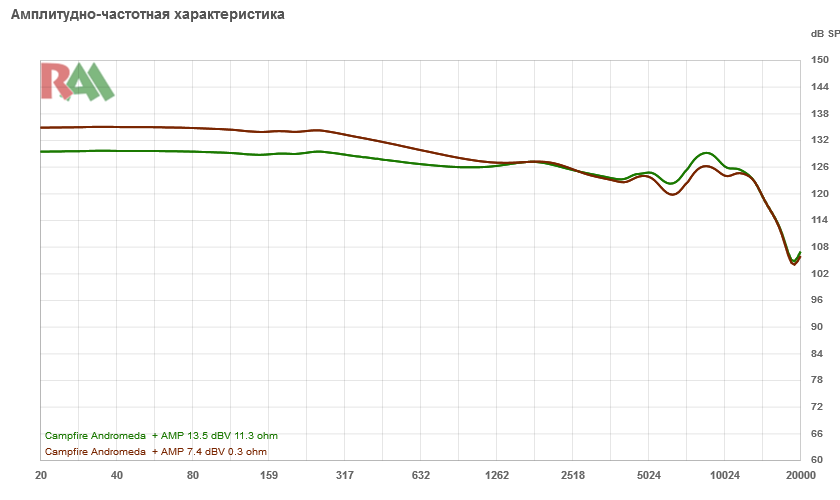 The amendment adds a correction of -20 dB in level for the “music” construction mode.
The amendment adds a correction of -20 dB in level for the “music” construction mode.On the graph with
Campfire Andromeda and amplifiers with parameters from HiFiMan Balanced Card, we see that in unbalanced mode, our headphones play louder at low frequencies by 6 dB, i.e. twice. In the high-frequency range, in balanced mode, 3 dB is louder than higher frequencies.
Is it really? Do not lie graphics? Thanks to the presence of a HiFiMan HM901 with a balanced card, this was easy to verify - the graph did show what was heard when switching modes.
It was a “cognitive” application of on-line service, in the next part we will consider options with practical application.